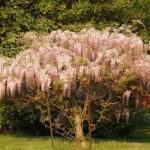Wisteria’s a beautiful and vigorous twining vine that grows and grows. They are decidous which means they will lose their leaves in the fall. If you have a large landscape to work with and a space where the wisteria can have free reign to do its thing, then you should consider adding this vine to your landscape. If you don’t have much space, with a commitment of keeping it trained and contained you should be able to have a wisteria.
Wisteria’s are very hardy and their growth is vigorous. They can actually live for a very long time. If left unattended to grow naturally they will climb very high.
The flowers are a delight. Once the wisteria reaches adulthood, large cluster-like flowers will occur in the spring. There are a range of colors including white, pink, lilac, shades of blue and shades of deep purple. Variance will depend on what your purchase. Plants that have been grown from seed may take upwards of ten years to bloom. Choose a plant that has been grafted or plants that are grown from a cutting or that has been layered from a flowering plant to enjoy blooms earlier.
In order for your wisteria to be healthy and bloom well the plant requires a spot in your landscape that receives full sun. Full sun means a spot that will have at least six hours of full sun hitting the spots. No shade spots. The soil needs to be slightly above normal on the pH scale and should not become to dry. The soil should be capable of retaining moisture. The spot you choose should also have a support system as the wisteria will need something to climb on as it matures.
You will need good site prep. Test your soil for the pH level. It needs to be slightly above 5.0. If not, add organic fertilizer to the area as you work. Prepare at least a 3 foot area and you need to dig down at least 2 feet. Keep the soil you have dug out for planting your wisteria.
You will need to construct a structure for your wisteria to climb on. Trellises, arbors and pergolas are all options for you to consider. Also, make sure you do not plant to close to your house or other structures as the wisteria vines can become entangled in the guttering system.
If you want a tree-like wisteria it will take more precise work. You must keep the plant staked upright. When it reaches about 5 feet in height, cut the top off. You can leave side shoots on the upper parts, but remove any from the lower trunk area. These side shoots should be pruned each winter until the top has reaches the desired diameter. Future pruning usually consists of cutting summer growth to the 6th leaf. Cut off any secondary shoots to the 1st leaf.
Once the soil is prepped and your support system is in place, your vine can be planted. Place the root ball in the hole spreading it out gently if needed. If the wisteria is grafted, set it so the graft union is just below the soil surface. Fill in the hole with the reserved soil and pat it around the root ball.
After planting make sure you water thoroughly. Make sure to saturate the entire area. New plants require about 1 inch of water per week.
Young plants should be fertilized once a year–no more. Once the plant has reached maturity you do not need to fertilize.
Since young plants are in the vegetation stage they will not have the extra energy to bloom. Do not give additional doses of fertlizer as this only helps promote more vegetation growth. If the wisteria does not look healthy in color though, you may want to give your plant an additional feeding of fertilizer. Water only if your wisteria looks like it is becoming wilted which may happen in drought conditions. Both overfeeding and overwatering will lead to excessive foliage growth and inhibit flowers from developing.
Some annual pruning will be required to maintain a healthy plant. It is not a good idea to just let the vine grow wherever it wants to. You should never let the wisteria overtake buildings or trees. It can cause damage to structures and may weaken or kill a tree. Pruning will help reduce the growth of the vine and help promote flowers.
You will have to train the plant. To start, select a sturdy upright stem as your main and attach it to your support system. Remove any side shoots from the main. As the main grows it will start to develop side branches. These side branches will then produce more shoots and eventually flowers. Training the main must continue upward and allow these side branches to develop as needed to form the plants framework. Side branches generally need about 18 to 20 inches between them to allow proper growth.
Keep your vine contained in the space that you have chosen for it. Cut off any obtrusive branches. The main needs to be trimmed and kept trimmed at the height that you desire for your plant.
During the summer when growth can become overwhelming it is necessary to prune. Allow only 1 strong leader to develop from the end of the main framework. Don’t prune this one unless it becomes too large. Attach this leader to the support and train as you did your main. Cut off all ends of new side shoots just to the 7th leaf as soon as possible. New shoots will form. As the shoots form, cut them back to where there is just two leaves. Too much foliage growth takes so much of the plant’s energy it will inhibit blooming.
In the winter you will need to cut back at least to 1/2 of their overall length. Cut side shoots back to where they are only a couple of inches in length. This pruning method will allow an excellent foundation for the branches to extend each year.
Once your plant has reached the desired size adjust your pruning to include any branches that seem out of place. In winter you should pay attention to the vines base and remove any “suckers” that may appear.
If your wisteria is already present on your landscape but wasn’t properly cared for, a little TLC can promote healthy growth and flowers. Start the healing process in the winter by pruning away all but a small framework of sturdy branches. Shorten these though. Be sure to remove any branches that are crowding and/or poorly spaced. Then start the basic pruning and training and you should have your wisteria blooming in two to three years.
Failure to bloom may be the result of inadequate sunlight or poor soil conditions. Excessive vegetation and excessive pruning can also result in an unflowering wisteria. Do not attempt to transplant as they do not usually recover well from the shock.
To get ideas check out the internet for pictures of trained wisteria to get ideas for your landscape and how to do proper pruning techniques for your landscaping.






